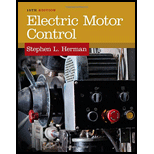
Concept explainers
If the contacts on a manual starter cannot be closed immediately after a motor overload has tripped them open, what is the probable reason?
Explain the probable reason for allowing the time duration to reset the starter contacts after they tripped off by the overload protection equipment of the motor.
Explanation of Solution
Discussion:
The overload protection of the motor trips off (open) the contacts of a motor starter when the load exceeds the normal range. The overload protection equipment (heater) gets heated during the overload condition.
The contacts of the starter can reset only after the overload protection equipment cools completely. If the contacts are closed immediately, the heater does not cool properly due to the insufficient time and it lead to damage the motor as the overload still exists.
Conclusion:
Thus, the contacts of the motor starter cannot close immediately when the motor overload has tripped them open.
Want to see more full solutions like this?
Chapter 2 Solutions
Electric Motor Control
- Add a second start button to the basic circuit so Start Button 1 or Start Button 2 can be used to start a motor. Include a second stop button that is connected so that Stop Button 1 or Start Button 2 can be used to stop the motor.arrow_forwardCircuit Logic. Match each statement to the proper circuit. All circuits have been drawn with a light (L) to represent the load, whether it is a motor, bell, or any other kind of load. In addition, each switch is illustrated as a pushbutton whether it is a maintained switch, momentary switch, pushbutton, switch-on target, or any other type of switch. from electrical motor controls for integrated systems workbook 2014 chapter 5arrow_forwardAssume ideal op-amp. If V_DC= 2.9, find I_L in mAarrow_forward
- R is 12 kΩ . Find the Thevenin equivalent resistance.arrow_forwardAssuming an ideal op-amp, design an inverting amplifier with a gain of 25 dB having the largest possible input resistance under the constraint of having to use resistors no larger than 90 kΩ. What's the input resist?arrow_forwardI need help with this problem and an explanation of the solution for the image described below. (Introduction to Signals and Systems)arrow_forward
- I hope the solution is on paper and not artificial intelligence. The subject is control systemarrow_forwardI hope the solution is on paper and not artificial intelligence.arrow_forwardVs R1 R2 ww ww 21x R3 Define the Thevenin equivalent of the above circuit where R1= 10 52, R2= 30 S2, R3 = 30 12, Vs = 70 V. VThevenin Number V RThevenin = Number Ωarrow_forward

 Electricity for Refrigeration, Heating, and Air C...Mechanical EngineeringISBN:9781337399128Author:Russell E. SmithPublisher:Cengage Learning
Electricity for Refrigeration, Heating, and Air C...Mechanical EngineeringISBN:9781337399128Author:Russell E. SmithPublisher:Cengage Learning

